34 min listen

Scaling Up, Up, Up, with CSTORM and EWN
Scaling Up, Up, Up, with CSTORM and EWN
ratings:
Length:
42 minutes
Released:
May 3, 2022
Format:
Podcast episode
Description
Welcome to the first episode of Season 4! Our theme is Up, Up, Up, with Nature-Based Solutions and we have a fabulous line-up of guests who are going to join us and talk about the climate change imperative – and the opportunity to collaborate on developing and implementing landscape-scale projects. Host Sarah Thorne and Jeff King, Deputy Lead of the Engineering With Nature Program at the US Army Corps of Engineers, are joined by two guests. Amanda Tritinger is the Assistant Program Manager for the EWN Program, and a Research Hydraulics Engineer at the Coastal and Hydraulics Laboratory in Vicksburg, Mississippi. Amanda is also a future cohost of the EWN Podcast. Matt Bilskie is Assistant Professor at the University of Georgia. Matt leads the Coastal Ocean Analysis and Simulation Team (COAST), a research team that develops computational hydrodynamic models to simulate astronomic tides, wind-waves, storm surge, and rainfall-runoff in coastal and oceanic environments. They are talking about how their work on innovative modeling will help project teams incorporate nature-based features into their coastal storm planning efforts. Amanda and Matt met at the University of Central Florida and share a passion for applying math and science to make the world a better place by helping coastal communities thrive. As part of her education, Amanda used numerical models to predict erosion and accretion in marsh environments in a national estuarine research reserve. In the process, she fell in love with the coast, which led to her PhD and ultimately her work with USACE. Matt, a native Floridian, witnessed the devastation caused by the very active hurricane seasons of 2004 and 2005 early in his college days. This experience, along with his interest in computers and coding, led to his study of coastal storm surge and flooding. Today, Amanda and Matt are actively involved in the Network for Engineering With Nature (N-EWN), a collaborative effort between USACE and the University of Georgia’s Institute for Resilient Infrastructure Systems (IRIS). They’re excited about their work together using the Coastal Storm Modeling System, or CSTORM. CSTORM is a very robust tool developed by Dr. Chris Massey at USACE’s Engineering Research and Development Center that, in real time, couples storm surge and wave modeling. CSTORM can model different scenarios for storm timing, whether a storm hits at high or low tide; how strong the winds are; how fast the storm is moving; and different sea-level-rise conditions. As Amanda says, “Using CSTORM, we're able to look at historical storms, and synthetic storms. We can look at a thousand different storm scenarios before those storms are seen and predict what would happen during those given events, and we can look at role of natural infrastructure on our coastline. We're able to share those storms with our partners at University of Georgia and have them run them through their different setups and do scaling that Matt has been working on.” An example schematic workflow for ERDC's CSTORM-MS. Source: ERDC CHL Fact Sheet. Matt’s focus is scaling up this modeling to evaluate natural infrastructure features in both inland and coastal areas. He’s using CSTORM to run various scenarios: “We’re thinking about flood-plain reconnection, removing or moving levees back from the immediate vicinity of the riverbank. We're talking about utilizing what exists and what nature does so well and its adaptation through wetlands, salt marshes, mangroves, oyster and coral reefs, barrier island systems, beach and dune systems, and many others. In a nutshell, when we're thinking about these natural features, we're really wanting to work with nature rather than keep nature out like we've done in the past with concrete, and levy and sea wall structures. So, it's a new paradigm in how we're approaching coastal engineering – a more holistic view.” He goes on to describe some of the initial work modeling the effects of the North Carolina
Released:
May 3, 2022
Format:
Podcast episode
Titles in the series (82)
Exploring How EWN Can Add Value to Climate Change Initiatives: In 2020, the United States experienced extreme droughts, wildfires, flooding, and a record number of hurricanes. What if there was a better way to monitor and prepare for these natural events, and how could an Engineering With Nature (EWN) approach... by EWN - Engineering With Nature